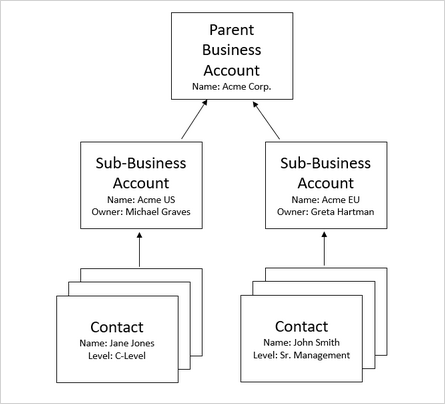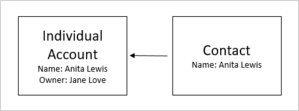
Prospect and customer data
The Pega Sales Automation™ Data Model consists of a set of standard business objects that support the sales process. The business objects have unique attributes (for example, account numbers, contact names, or operator IDs), and they interact with other business objects as they move through the sales life cycle.
Pega Sales Automation uses the Pega Common Data Model (CDM). To review the CDM documentation, including the Entity Relationship Diagram (ERD) and the Data dictionary, see Pega Common Data Model documentation page.
Pega Sales Automation includes the following business objects:
Activity, Appointment, Competitor and Competitor product, Email, Lead, Opportunity, Relationship map, Task, Territory, and Territory dimension.
In addition, Pega Sales Automation uses the following CDM objects:
Account (Business, Customer and Household), Asset, Contact, Product, and Service account.
Business objects depend on the selling mode that you select for your implementation. In Pega Sales Automation, you can use the following selling modes:
Business-to-Business (B2B): For use with selling products and services to other businesses.
Business-to-Consumer (B2C): For use with selling products and services directly to individual consumers.
Mixed mode: For use with selling products to both individual consumers and to other businesses.
The prospect and customer data depend on the selling model. If you are selling to a business with the business-to-business model (B2B), you supply one type of data. If you are selling to an end consumer with the business-to-consumer model (B2C), you supply another type of data.
Account types
Business Account - represents a business that is buying or selling with the client.
Consumer Accounts - usually would be created as a part of creating a contact OR when a contact related to a household or business begins purchasing products as a consumer.
Household Accounts - provides a way to logically group contacts together so that clients can more accurately understand the value of the Household (aka Family Unit) members.
Business-to-business (B2B)
B2B prospect and customer data include information about the following entities: Business Account and Contact.
The business account hierarchy represents the levels of the customer or prospect business structure. This hierarchy helps organize and understand the relationships between different entities within the business, facilitating effective sales and account management strategies.
Acme Corp. has two sub-business accounts: Acme US and Acme Eu. Each sub-Business account has an account and owner.
Business-to-consumer (B2C)
B2C prospect and customer data include information about the following entities: Contact, Individual account, and Household.
In the B2C selling mode, the account is directly linked to a single contact. The individual account entity is an extension of the contact. The account has an owner. The contact is the person interested in making a purchase.
Household
A household is a grouping of contacts, usually with the intent to purchase a common product (for example, insurance with coverage for all family members).
The most common household grouping consists of family members living at the same address. However, a household can also be used to group any set of contacts that share a commonality.
The household must have one primary contact identified as the head of the household. Households are used only in the B2C selling mode.
This Topic is available in the following Module:
If you are having problems with your training, please review the Pega Academy Support FAQs.
Want to help us improve this content?



